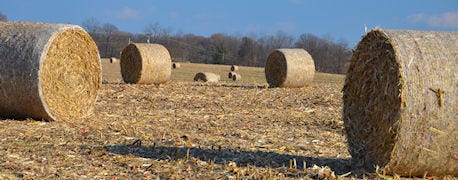December 5, 2012

Even after a reasonably good growing season, some Northeast beef and dairy producers are still worried about feed costs and adequate supplies. Your window is closing on the opportunity to bag or bale an inexpensive forage – corn stover. And grain farmers with heavy crop residues may welcome your offer to take it off their fields.

BALED TO GO: Corn stalks, husks and cobs in this York County, Pa., field are destined to be inexpensive feed for beef or dairy cattle.
"When corn is harvested, 58% of the dry biomass is grain, leaving 42% that's made up of corn cobs, stalks, husks and leaves," says Steve Peterson, end-use product manager for Monsanto's Corn Product Management Team. Treating corn stover with lime (calcium hydroxide) and water can produce a palatable, economical feed for beef cattle, dairy heifers and dry cows.
Calcium hydroxide can be applied on corn stover windrows before chopping or baling. It isn't rocket science, claims Peterson. "This is an old idea that's new again."
"We did this in the early '70s because we had $3 corn. Why was it discontinued? Because corn prices dropped to $1.50 a bushel, and nobody cared anymore about feeding less corn. High corn prices are bringing it back."
A good feed gone to waste?
So far, research studies at Nebraska, Iowa State and Illinois suggest that up to 25% of corn feed can be replaced with lime-treated corn stover with no adverse impact on cattle's physical development. It raises forage pH and boosts stover digestibility.
A Nebraska trial involving 336 steers concluded that a ration of 20% treated corn stover performed as well as the typical untreated high-grain diet. In a similar Iowa State trial involving 210 steers, lime-treated corn stover fed with dry distillers grains allowed the percentage of grain in the rations to be cut between 35% and 70% without affecting animal development.
Once windrowed by rake or hay merger, the stover can be harvested with a chopper or large baler. That'll depend on your intended use and stover moisture. Even if you don't need the feed this year, keep stover harvest in mind for future use. Watch for more details in an upcoming issue of American Agriculturist.
You May Also Like




